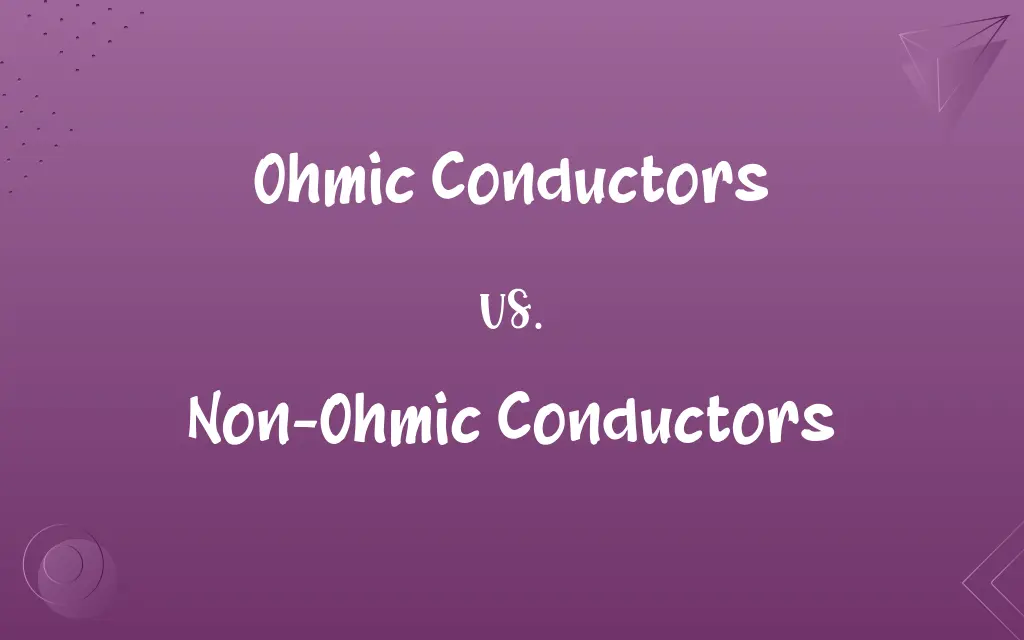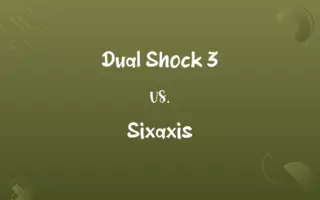Ohmic Conductors vs. Non-Ohmic Conductors: Know the Difference

By Shumaila Saeed || Published on February 19, 2024
Ohmic conductors follow Ohm's Law with a linear V-I relationship; Non-Ohmic conductors do not, displaying a nonlinear V-I curve.

Key Differences
Ohmic conductors are materials that adhere to Ohm's Law, implying a direct proportionality between voltage (V) and current (I), resulting in a constant resistance. In contrast, Non-Ohmic conductors do not follow this linear relationship; their resistance changes with voltage and current.
Shumaila Saeed
Feb 19, 2024
The behavior of Ohmic conductors is predictable and consistent over a range of applied voltages, making them ideal for many electrical circuits. Non-Ohmic conductors, however, exhibit a variable response, often due to factors like temperature changes or electronic structure, which affects their conductivity.
Shumaila Saeed
Feb 19, 2024
In Ohmic conductors, the linear V-I graph is a straight line passing through the origin. For Non-Ohmic conductors, the V-I graph is typically curved, indicating the deviation from Ohm's Law and the changing resistance.
Shumaila Saeed
Feb 19, 2024
Common examples of Ohmic conductors include most metals like copper and aluminum, which maintain uniform resistance under constant temperatures. Non-Ohmic conductors include semiconductors like silicon and germanium, diodes, and transistors, which have variable resistance properties.
Shumaila Saeed
Feb 19, 2024
The practical application of Ohmic conductors is widespread in standard electrical appliances and industrial machinery. Non-Ohmic conductors are crucial in specialized electronic components like microchips and sensors where variable resistance is required.
Shumaila Saeed
Feb 19, 2024
ADVERTISEMENT
Comparison Chart
V-I Relationship
Linear, follows Ohm's Law
Nonlinear, does not follow Ohm's Law
Shumaila Saeed
Feb 19, 2024
Resistance Characteristic
Constant under stable conditions
Variable, dependent on factors like temperature
Shumaila Saeed
Feb 19, 2024
Graph Representation
Straight line through origin in V-I graph
Curved line in V-I graph
Shumaila Saeed
Feb 19, 2024
Common Examples
Metals like copper, aluminum
Semiconductors, diodes, transistors
Shumaila Saeed
Feb 19, 2024
Typical Applications
Electrical appliances, industrial machinery
Microchips, electronic sensors, specialized devices
Shumaila Saeed
Feb 19, 2024
ADVERTISEMENT
Ohmic Conductors and Non-Ohmic Conductors Definitions
Ohmic Conductors
Materials where the resistance remains unchanged with varying voltage.
Aluminum, an Ohmic conductor, is used in power lines for its stable resistance.
Shumaila Saeed
Jan 20, 2024
Non-Ohmic Conductors
Non-Ohmic conductors have unpredictable electrical characteristics under varying conditions.
Light-emitting diodes (LEDs) are Non-Ohmic conductors with variable electrical properties.
Shumaila Saeed
Jan 20, 2024
Ohmic Conductors
Ohmic conductors have a predictable electrical behavior under constant conditions.
Electrical heaters using Ohmic conductors provide a steady heat output.
Shumaila Saeed
Jan 20, 2024
Non-Ohmic Conductors
Materials whose resistance changes with factors like temperature or voltage.
A thermistor is a Non-Ohmic conductor used for temperature sensing.
Shumaila Saeed
Jan 20, 2024
Ohmic Conductors
Ohmic conductors exhibit a proportional relationship between voltage and current.
The light bulb, an Ohmic conductor, glows consistently due to its linear V-I relationship.
Shumaila Saeed
Jan 20, 2024
ADVERTISEMENT
Non-Ohmic Conductors
Conductors that demonstrate a curved graph in voltage-current analysis.
The transistor in a computer chip, a Non-Ohmic conductor, has a curved V-I characteristic.
Shumaila Saeed
Jan 20, 2024
Ohmic Conductors
Conductors that follow the linear graph in voltage-current analysis.
The resistor in a circuit board acts as an Ohmic conductor, ensuring a stable current flow.
Shumaila Saeed
Jan 20, 2024
Non-Ohmic Conductors
Materials that do not follow Ohm's Law, showing variable resistance.
A semiconductor device is a Non-Ohmic conductor with changing resistance.
Shumaila Saeed
Jan 20, 2024
Ohmic Conductors
Materials that obey Ohm's Law, maintaining constant resistance.
Copper wires in household circuits are Ohmic conductors.
Shumaila Saeed
Jan 20, 2024
Non-Ohmic Conductors
Non-Ohmic conductors exhibit a nonlinear V-I relationship.
The diode, a Non-Ohmic conductor, displays a nonlinear response to voltage changes.
Shumaila Saeed
Jan 20, 2024
Repeatedly Asked Queries
Do Non-Ohmic conductors have a constant V-I slope?
No, Non-Ohmic conductors have a variable V-I slope.
Shumaila Saeed
Feb 19, 2024
What is a Non-Ohmic conductor?
A Non-Ohmic conductor does not follow Ohm's Law and has variable resistance.
Shumaila Saeed
Feb 19, 2024
Can Ohmic conductors work at all voltages?
Ohmic conductors work consistently at different voltages under stable conditions.
Shumaila Saeed
Feb 19, 2024
Is the resistance of Ohmic conductors affected by temperature?
Yes, but under normal conditions, the effect is minimal.
Shumaila Saeed
Feb 19, 2024
Is copper wire an Ohmic conductor?
Yes, copper wire is a common example of an Ohmic conductor.
Shumaila Saeed
Feb 19, 2024
What defines an Ohmic conductor?
An Ohmic conductor follows Ohm's Law with a constant resistance.
Shumaila Saeed
Feb 19, 2024
Are all metals Ohmic conductors?
Most metals are Ohmic conductors, but not all.
Shumaila Saeed
Feb 19, 2024
Can Ohmic conductors be used in electronics?
Yes, Ohmic conductors are used in basic electronic components.
Shumaila Saeed
Feb 19, 2024
What causes Non-Ohmic behavior?
Factors like temperature, electronic structure, and material properties cause Non-Ohmic behavior.
Shumaila Saeed
Feb 19, 2024
Are semiconductors Non-Ohmic?
Yes, semiconductors are typically Non-Ohmic conductors.
Shumaila Saeed
Feb 19, 2024
Are light bulbs Ohmic or Non-Ohmic?
Incandescent light bulbs are generally Ohmic conductors.
Shumaila Saeed
Feb 19, 2024
Is aluminum an Ohmic conductor?
Yes, aluminum is an example of an Ohmic conductor.
Shumaila Saeed
Feb 19, 2024
How does a thermistor behave?
A thermistor is a Non-Ohmic conductor with resistance varying by temperature.
Shumaila Saeed
Feb 19, 2024
Do Ohmic conductors always have a linear V-I relationship?
In normal operating conditions, they maintain a linear V-I relationship.
Shumaila Saeed
Feb 19, 2024
Do diodes follow Ohm's Law?
No, diodes are examples of Non-Ohmic conductors.
Shumaila Saeed
Feb 19, 2024
What is the key feature of a Non-Ohmic conductor in electronics?
Its ability to change resistance under different conditions is key in electronics.
Shumaila Saeed
Feb 19, 2024
What applications utilize Non-Ohmic conductors?
Non-Ohmic conductors are used in advanced electronic devices like microchips and sensors.
Shumaila Saeed
Feb 19, 2024
What happens to Ohmic conductors at very high temperatures?
At extremely high temperatures, Ohmic conductors may behave non-linearly.
Shumaila Saeed
Feb 19, 2024
Can Non-Ohmic conductors have a straight V-I graph?
No, Non-Ohmic conductors typically have a curved V-I graph.
Shumaila Saeed
Feb 19, 2024
Are Ohmic conductors used in power transmission?
Yes, due to their stable resistance, they are commonly used in power transmission.
Shumaila Saeed
Feb 19, 2024
Share this page
Link for your blog / website
HTML
Link to share via messenger
About Author
Written by
Shumaila SaeedShumaila Saeed, an expert content creator with 6 years of experience, specializes in distilling complex topics into easily digestible comparisons, shining a light on the nuances that both inform and educate readers with clarity and accuracy.




































































